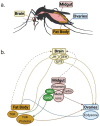Wolbachia's Deleterious Impact on Aedes aegypti Egg Development: The Potential Role of Nutritional Parasitism
- PMID: 33120915
- PMCID: PMC7692218
- DOI: 10.3390/insects11110735
Wolbachia's Deleterious Impact on Aedes aegypti Egg Development: The Potential Role of Nutritional Parasitism
Abstract
The artificial introduction of the endosymbiotic bacterium, Wolbachia pipientis, into Aedes (Ae.) aegypti mosquitoes reduces the ability of mosquitoes to transmit human pathogenic viruses and is now being developed as a biocontrol tool. Successful introgression of Wolbachia-carrying Ae. aegypti into native mosquito populations at field sites in Australia, Indonesia and Malaysia has been associated with reduced disease prevalence in the treated community. In separate field programs, Wolbachia is also being used as a mosquito population suppression tool, where the release of male only Wolbachia-infected Ae. aegypti prevents the native mosquito population from producing viable eggs, subsequently suppressing the wild population. While these technologies show great promise, they require mass rearing of mosquitoes for implementation on a scale that has not previously been done. In addition, Wolbachia induces some negative fitness effects on Ae. aegypti. While these fitness effects differ depending on the Wolbachia strain present, one of the most consistent and significant impacts is the shortened longevity and viability of eggs. This review examines the body of evidence behind Wolbachia's negative effect on eggs, assesses nutritional parasitism as a key cause and considers how these impacts could be overcome to achieve efficient large-scale rearing of these mosquitoes.
Keywords: Aedes aegypti; Wolbachia; biocontrol; nutritional parasitism.
Conflict of interest statement
The authors declare no conflict of interest.
Figures

References
-
- Michael B., Deen J., Buchy P., Gubler D., Harris E., Homach J. World Health Organization Dengue Guidelines for Diagnosis, Treatment, Prevention, and Control. WHO Publisher; Geneva, Switzerland: 2009. p. 3.
Publication types
Grants and funding
LinkOut - more resources
Full Text Sources

